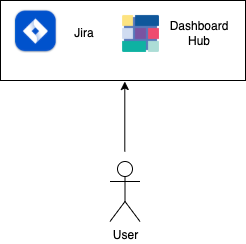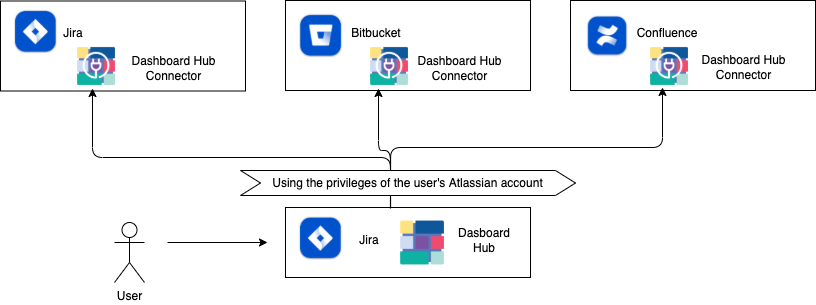Learn about Datasources
Overview
Datasources are the entities that securely connect your instance with the tools where your data is. For example, the default datasource is the instance where the app is installed, which needs no configuration.
This data is collected thanks to the integrations provided by the app (see Dashboard Integrations: Supported Products for further information).
Datasources and gadgets
Each gadget uses a datasource, and several gadgets can share the same datasource. Initially, when you configure your first gadget in a dashboard, you can opt for having all the compatible gadgets automatically configured with that datasource. Imagine that in your dashboard there are four gadgets that use Bitbucket as datasource, when you configure the first one, the rest can be automatically configured with the same datasource.
See Add and Manage Datasources to see how to configure a datasource.
Access restrictions in datasources
Datasources fetch and display information from external products, which sometimes you may want to keep for yourself. In this case, you can configure access restrictions and avoid anyone else from using your datasources. You’ll find the following options to set up access restrictions:
My organization. Any logged in user in your instance can use this datasource.
Private. Only the creator of the datasource can use it.
This restriction can be set when you create the datasource, or accessing through the lock menu. It’s indicated with an unlock icon if My organization is selected and with a lock icon if Private is selected.
Type of datasources
Dashboard Hub uses three different types of datasources:
Default datasource
The default datasource is the Jira cloud instance where the app is installed, and it is called the default datasource. You won’t need to configure anything else. This datasource retrieves the data from the current Jira cloud instance. The main characteristics are:
It is enabled by default, no need for further configuration. It can be selected right away in compatible gadgets.
It has access to the Jira cloud instance where the app is installed.
Data access and permissions are the ones of the user who created the dashboard (dashboard owner). Thus, users have the very same permissions that they have in the Jira instance.

Connector app
The Dashboard Hub Connector app is a special app that you install on some Atlassian cloud products like Jira (Core, Software, Service Management), Confluence and Bitbucket (includes Pipelines).
This app is a bridge to bring data from others other Atlassian products, keeping users and security privileges configured on every instance. This means that users can access data from other Atlassian cloud products only if their Atlassian accounts have the right and sufficient privileges.
Thus, it is possible to grant access to other datasources in a fast and easy way, while maintaining data security without additional configuration. The main characteristics are:
Data access managed on and by each Atlassian Cloud product instance.
It just requires an admin to install the app and you are ready to go!
It requires Dashboard Hub for Jira (paid app) to be installed in the main instance, but the Dashboard Hub Connector apps are free apps!

API Token
This type of datasource is required when the source of the data does not allow to install a connector app. In this case, you need to provide a user name and an API Token, so that the app can access and retrieve the information from these external sources. This mechanism is pretty common for integrations with third party vendors, and sometimes with Atlassian products too.
So, the API Token allows retrieving data from services and tools like the Atlassian Marketplace, Opsgenie, Statuspage (all avaiable today), and others available soon (see Dashboard Integrations: Supported Products). The main characteristics are:
It provides data access to several third party products and services.
No need to install extra apps, just the API Token.
The access is limited by the API Token. It will just allow to retrieve the data allowed by API Token.
.png?inst-v=7c55e037-6dfd-4f5a-b50d-b866364e77a2)
See also
- Dashboard Hub Connector Apps
A connector app is a special app to integrate with external Jira instances, Confluence or Bitbucket
- Dashboard Integrations: Supported Products
Discover what products can be integrated now and what will be soon
- Add and Manage Datasources
Learn how to add and configure datasources
- Set Up a Wallboard
Set up your information radiator: A wallboard
- Add and Configure Gadgets
Learn how to add and configure gadgets in dashboards
- Learn about Datasources
Learn what datasources are, what types there are and why are they one of the key assets in dashboards
- What is a Gadget?
Gadgets are the small components in a dashboard that visually transmit the data with graphs, tables, images, text, etc.
- Jira Dashboards: Native Gadgets and Product Integrations
Enjoy all the gadgets and product integrations in your Jira Dashboards natively.
- Dashboard Data Perspectives: Dynamic Filter
Customize how you view dashboards using dynamic filtering.
- Dashboard Demos: Live Examples for ITSM, DevOps, Agile, Project Tracking
Find live examples of different dashboards to discover what you can do with Dashboard Hub
- How to level up your IT Service Management
Let users of your Customer Portal in your Jira Service Management (JSM) instance access live dashboards, and report JSM metrics with multi-project gadgets.
- How to Enhance your Data Visualization
Dashboard Hub enhances your data visualization with Pre-defined templates, 70+ ready-to-go gadgets and powerful integrations.
- Dashboard Gadgets: KPIs and Metrics
Here, we classify gadgets by dashboards, but you can combine any of them in a single dashboard as you wish!
- Hybrid Dashboards: Data from Server, Data Center and Cloud in the same Dashboard
Find out everything about Hybrid Dashboards: Data from server, data center and/or cloud in the same dashboard